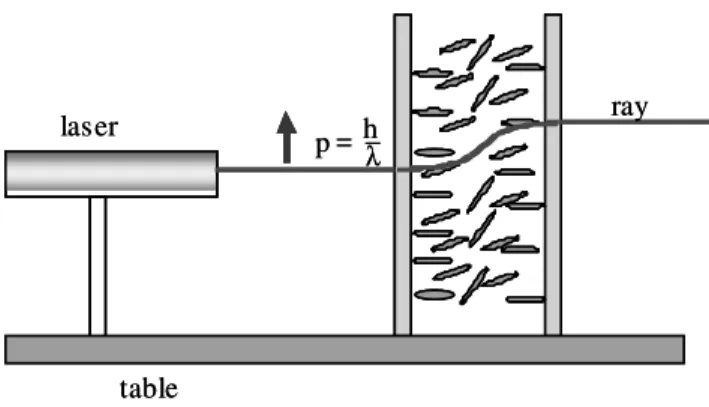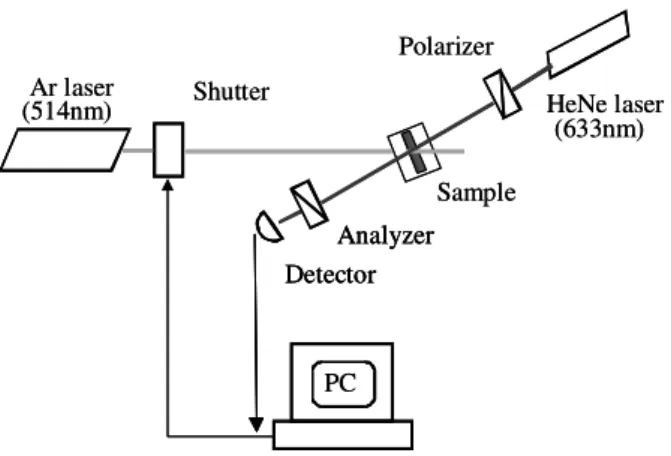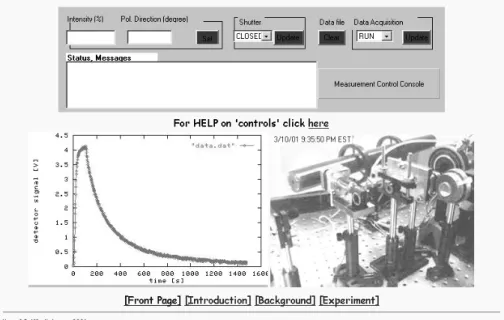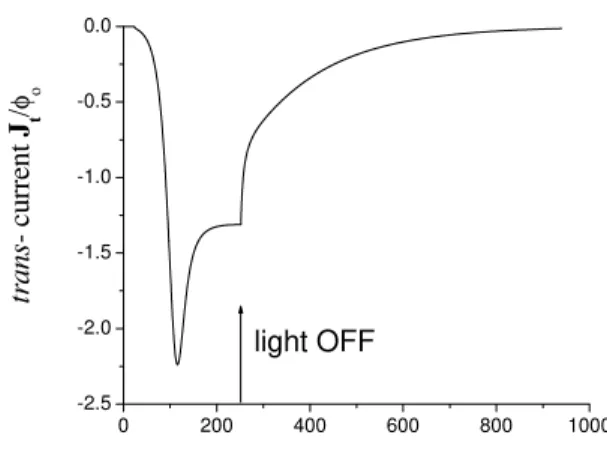Brownian Rathets and the Photoalignment
of Liquid Crystals
P.Paly-Muhoray a
, T. Kosa a
, and Weinan E b
a
LiquidCrystalInstitute,KentStateUniversity,Kent, OH44242
b
Mathematis Department, PrinetonUniversity,Prineton,NJ08544
Reeivedon11Deember,2001
Moleular motorsplaykeyrolesinareasrangingfrom biologialtransporttoemerging
nanoteh-nology. Theyprodueurrentasaresultoftransferofenergybutnotofmomentumfromasoure;
manymoleularmotorsenariosarebasedonthetranslationalBrownianrathetmehanism. Here
weonsiderthemehanismofphotoalignmentofliquidrystalsbothinthebulkandatthesurfae
byaphotosensitivealignment layer. Weshowthatthe photoalignmentis dueto anorientational
rathet mehanism, where the azo-dye moleules, funtionalized into a polymer alignment layer,
whenirradiated by polarizedlight at as the rotors of Brownianmotors whihreorient the bulk
liquidrystalagainstanelastirestoringtorque.Resultsofthisphotoalignmentexperimentanbe
obtaineddiretlyfromaremoteexperimentsetupattheLiquidCrystalInstitute,viatheWWW.
Inadditiontoexperimentalresults,wepresentadetailedFokker-Plankdesriptionofthissystem.
Wedisusstheimplementationand theresults ofnumerialsimulations, andomparethesewith
theexperimentallyobserveddynamis.
I Introdution
Itiswellknownthat lightanexertaforeonmatter;
radiation pressure on a reeting metal surfae, or a
blakabsorbingsurfaearewellknownexamples. Itis
perhapslesswellknownthat lightfallingfromvauum
onadieletriinterfaeexertsaforewhihattratsthe
interfaetowardsthesoureoflight[1℄. In1936, R.A.
Bethshowedthatlightanalsoexertatorque[2℄;inhis
example,thetorque,alongthewavevetoroflight,was
due to thetransferof intrinsi(spin) angular
momen-tum from the radiationeld to thematerial. In1969,
A. Saupe showed that light an also exert a torque,
perpendiulartothewavevetor,onliquidrystals[3℄;
thiseethassubsequentlybeenredisoveredbyothers
[4-7℄andhasbeenthesubjetofonsiderableattention.
InSaupe'sexperiment,the torqueisdue to the
trans-fer of extrinsi (orbital) angular momentum from the
radiationeldto thematerial[8℄.
In 1990, Janossy showed that by adding a small
amountofdihroidyetotheliquidrystal,the
thresh-old intensity for the light indued reorientation is
re-dued by sometwoorders ormagnitute [9℄[10℄. Sine
in this ase the transfer of extrinsi angular
momen-tum from light is also redued by some two orders of
magnitude while the elasti restoring torques remain
unaltered,it is learthat thetorque felt by theliquid
rystal annot originate in angular momentum
trans-balane in this systemposed an interesting and
hal-lenging problem. We have suggested that this
`rota-tion without torque' is anorientationalversion of the
translationalrathetmehanism, apableofproduing
`motionwithoutfore',proposedbyAstumian[11℄and
Prost [12℄,and thatthetorque isarriedfrom theell
wallsby visousshear tothe dyemoleules,whihat
asrotors of aBrownian motor [8℄. Subsequently, this
model hasbeensigniantlyexpanded[13,14℄.
In this paper, we argue that photoalignment by
dyedopedphotosensitivealignmentlayersan alsobe
due to therathetmehanism,where thedihroidye
moleulesin thealignmentlayeratasrotorsof
Brow-nianmotors.
I.1. Biologial transport
It is interesting to explore parallels in the
under-standing of angular momentum balane in the
pho-toalignment of liquid rystals, and of the mehanism
oftransportinbiologialsystems. Essentiallyallliving
organisms (the eukaryoti ells of yeasts, plants,
ani-mals)ontain`motorproteins'. Twowellknown
exam-ples are kinesins andmyosins. Kinesin hastwoative
heads,ithydrolyzesATP,andmovesalongproessively
alongmitotubules.
Myosinalsohastwoativeheads,italsohydrolyzes
ATP,and itmovesproessivelyalongatin bers.
fun-tissue. The atin bers in musleare onnetedto
Z-membranesforming theend ofsaromeres;themotion
of the myosin headson theatin bersresults in
ten-sion ofthe myosin strands,ontrationofthe
sarom-eres,andofthemusleber[15℄. Themyosinbersare
approximately15m long,exertaforeof5pNper
attahed head,thestep-sizeis 5:5nmandthereisone
step/ATP-asereation.
Figure 1. Shematiofkinesin arryingargo alonga
mi-rotube.
The mehanisms responsible for the transport of
both kinesin and atin has been the subjet of
on-siderabledisussionintheliterature. Theonventional
viewhasbeenthat myosintransporttakesplaeviaa
`lever-armswinging'model,whileatintransporttakes
plae via`hand-over-hand'motion[16℄.
myosin
actin
sarcomere
muscle fiber
Figure2. Shematiofmyosinmovementresulting in
mus-leontration.
Reent experimental results have however ast
doubt on the validity of these models. Ishii and
Yanagidashowed[17℄thatproessivetransportanbe
observedinmyosinsubfragmentswhiharewithoutthe
full mehanial`lever-arm'omponent,indiatingthat
the `lever-arm' model annot adequately explain the
mehanism of the observed motion. Similarly, Okada
and Hirokawadeveloped amutantsuperfamily of
one-[18℄. Theirresultsuggestedthat the `hand-over-hand'
motionannotadequatelyexplainthemehanismofthe
observedmotion. Theonventionalmehanialmodels
thus apparentlyfailedto explainthedetails ofthe
ob-servedproessivetransport.
It hasnowbeenproposed that both in thease of
atin and of myosin, the mehanism for the observed
`motionwithout fore' is the biasedBrownian rathet
[19,20℄;that is, essentiallythesamemehanismwhih
isresponsiblefortheanomalousthresholdredutionin
the Janossy eet, and, as we argue below, for
pho-toalignmentbydyedphotosensitivealignmentlayers.
I.2 Motors and diusive transport
Inviewofonsiderablereentdisussionof
moleu-larmotorsin theliterature, itis interestingtoinquire
intothedenition ofamotor. Wenote thateven
on-ventionalmotorshavethefeaturethattheygiveriseto
`motion without fore'. For example, in the road-ar
system,thear typiallymoves,not asaresultsof an
externallyapplied fore, but beause themotor ofthe
ar auses onepart of the system (the road) to exert
afore ontheother (thear) withoutanymomentum
transferfromoutsidethesystem. Aworkingdenition
ofmotormaythereforebe: thatwih ausesmotion in
asystemwithoutmomentumtransferfromtheoutside,
or,alternately,amahine thatusesenergybutnot
mo-mentumtodriveaurrent.
Diusivetransportisthenamegiventomodel
pro-esses[21℄whihandriveaurrentofpartilesagainst
anopposing visous fore. Unlikein onventional
mo-tors, intertiadoesnot play arole. Oneearly example
of diusive transport is the beautiful model proposed
byR.Landauer[23℄,whih hasbeomeknownas
Lan-dauer'sBlowtorh. Herepartilesexperieneaspatially
periodisymmetrisinusoidalpotentialaswellasa
pe-rioditemperatureeld,asshowninFig. 3.
Sinethetemperatureisshiftedrelativeto the
po-tential, partiles near the left side of the valleys are
at a higher temperature than those near the right;
onsequently they aremore likelyto be thermally
ex-itedoverthe potentialbarrier and diuseto theleft.
The heat soure in this arrangement therefore drives
asteady urrent of partiles against an opposing
trans-x
T(x)
x
U(x)
Figure 3. Landauers's Blow torh. Partiles experiene
a stati sinusoidal temperature eld: the temperature is
shifted=4relativetothepotential.
A shemati of the translational rathet of
Astu-mian[11℄andProst[12℄isshownin Fig. 4.
U
x
U=0
x
U
x
U
x
U=0
x
U
x
Figure4.Shematiofthetranslationalrathet.
WhentheasymmetripotentialisturnedOFF,
par-tiles diuse evenly in both left and right diretions,
and the net urrent is zero. When the potential is
turnedON,thepartilesundergodireteddiusion
un-der the inuene of the potential, resulting in a net
urrentto the left. A salientfeature of therathetis
aspatiallyperiodiasymmetripotentialwhihis
peri-odiintime. Theproessisdiusiveratherthan
inter-tial;thepotentialdrivesaurrentagainstanopposing
visous fore. Turning the potential ONand OFF
re-quiresatransferofenergy,but notofmomentum.
We now onsider the Janossy eet (bulk
pho-toalignment) and a photoindued twist experiment in
moredetail,andarguethatthekeyunderlyingproess
isanorientationalrathetmehanism.
II Liquid rystals
Liquid rystalsareanisotropiuids, haraterized by
orientationalorder oftheonstituentmoleules. They
are responsive `soft' materials, sine their inherent
anisotropyprovidesamehanismofouplingto elds,
andtheiruidityallowsalargeresponse.
Moleulesofnematiliquidrystalsprefertobe
par-allel;thediretionofaverageorientationofthe
moleu-larsymmetryaxesisdesribedbytheunitvetor
dire-tor eld. Nematis with positivedieletri anisotropy
also prefer to align with an applied eletri eld; this
eetplaysakeyroleinliquidrystaldisplays.
Mole-ularanisotropyalsoresultsindiretiondependent
sur-fae interations.
Thefreeenergydensity,in theoneelastionstant
approximation,isgivenby[22℄
F= Z
1
2
K[(r^n ) 2
+(r^n) 2
℄ "(^nE) 2
dV Z
W ( ^
N^n) 2
dA (1)
d
where K isan elastionstant, thedyad"^n^n isthe
anisotropi part of the dieletri tensor, E is the
ap-pliedeletrield, W is ananhoringstrength and ^
N
istheeasyaxisofalignmentatthesurfae. Inasample
of lineardimension R ,the rstterm onthe r.h.s.
de-sribingtheenergyostofanon-uniformdiretoreld,
isproportionaltoR ,whilethelasttermdesribing
sur-fae interationsisproportionalto R 2
. Consequently,
in largesamples(R >K =W), in theabseneof elds,
surfaeinterationsdominateanddeterminethe
orien-tation. FromEq. (1), thetorque pervolumedue to a
statieletrield isgivenby
DC
="(^nE)^nE=DE (2)
When the diretor is parallel to the eletri eld, the
torquevanishes.
If light is propagating in the liquid rystal, the
torquedensityduetomomentum transferfromlightis
the anisotropipartof theMaxwellstress tensor; this
givesthediretoptialtorque
whose formisthesameasin thestatiase.
II.1 Experimental observations
II.1.1 Optial reorientation in thebulk
Theoptial Freederiksztransition. Ifplanepolarized
light is normallyinident on anemati ell where
an-horingonditionsaresuhthatthediretorisnormal
to theellwalls,then,aboveathresholdintensity, the
diretor tendsto align alongthe eletrield;that is,
along the diretion of polarization of the light. This
is the optial Freederiksz transition. A shemati is
shownin Fig. 5. Due to anisotropy,D is notparallel
to E, and theray isdeeted. Angularmomentum is
transferred fromthelighttotheliquidrystal.
laser
ray
table
_
h
p =
λ
laser
ray
table
_
h
p =
λ
Figure5. ShematioftheoptialFreederiksztransition.
Theoptialtorque
OPT
isbalaned bytheelasti
torque
ELAST
=K^nr 2
^
n (4)
ingoodagreementwithexperimentalobservations[24℄.
The Janossy Eet. In 1990, Janossy showedthat if
a small amount (< 1%) of adihroi dye is dissolved
intheliquidrystal,thethresholdintensityforthe
op-tial Freederiksz transition an be redued by up to
twoordersofmagnitude[9℄. Theanomalousredution
of thethreshold intensityis theJanossy eet. Inthe
Janossyeet,theelastitorqueremainsessentiallythe
sameasinthepurematerial,sinetheelastionstant
isnotaetedsigniantlybythepreseneofthesmall
amountofdye[10℄,however,sinethethreshold
inten-sity is redued by sometwo orders of magnitude, the
diretoptialtorqueisorrespondinglyredued. Sine,
aspointedoutbyJanossy[10℄,thediretoptialtorque
isnotsuÆienttooverometheelastitorque,a
dier-entsoureof torquemustexist.
II.1.2 Optial alignment atsurfaes
Photoalignment.
Sine surfae interations often determine the
ori-isofgreatpratialimportane. Inmostliquidrystal
displays, thin mehanially bued polymer layers
es-tablishsurfaealignmentofthediretor. Beauseofits
potentialfordisplayand optialmemoryappliations,
the photoalignment of liquid rystals by
photosensi-tivealignmentlayersgeneratedagreatdealofinterest.
Oneirreversiblesheme usespolarized lightto ahieve
diretion-seletive ross-linking [25,26℄ or breaking of
polymerhains[27℄. Areversibleshemeusesa
photo-sensitivealignmentlayerwheredyemoleulesareeither
ovalentlyattahedto thesubstratesurfae[28℄ or
in-orporatedinto apolymermatrix[29℄. Herepolarized
illuminationalterstheorientationofthehromophores,
whihresultsinthehangeofthediretionoftheeasy
axis. This latter sheme shows onsiderable potential
forappliations[30℄,thephotoinduedtwistexperiment
disussedbelowmakesuseofit.
Azo dyes
Azo dyes are ompounds ontaining-N=N- (azo)
groupswhiharelinkedtovarious organigroups
(sub-stituents) through sp 2
hybridized arbon atoms [31℄.
Withrespettobothprodutionandvariety, azodyes
arebyfarthelargestgroupofommerial olorants.
Due to the presene of the lone-pair eletrons on
the nitrogens, the azo bond, although planar, is not
linear. Therearetwostereoisomersofazoompounds,
dependingontherelativepositionofthelone-pairsand
substituents as shown in Fig. 6. Interestingly,
al-thoughazodyes were ommeriallyprodued asearly
as1861,the trans-is isomerizationwasdisoveredby
G.S.Hartlyonlyin1937.
Figure 6. Trans- and is- isomers of azobenzene. (The
emptyirles onthe doublybondednitrogens indiatethe
lone-pairseletrons.
The elongated trans-isomer is thermodynamially
stable,whilethehigherenergyis-isomerismetastable.
The lowest energy optial exitation of azobenzene
derivatives promotes non-bonding lone-pair eletrons
to anti-bonding -like moleular orbitals, and is
des-ignated as (n;
) transition. The next higher energy
exitation indues a (;
) transition. Following the
exitation,atransitionbetweenthetwoisomeriforms
is possible. In general, there are two pathways
avail-ablefortheisomerization;rotationandinversion.
isomer-mehanism is greatly inuened by the nature of the
substituent groups and by the exitation energy.
Re-entresultsoffemtoseondspetrosopimeasurements
supporttheideathat (n;
) exitation ofazobenzene
leadstoisomerizationviainversionatoneofthe
nitro-genatoms[32℄.
Due to the nature of the proess, there are three
propertiesthathangeuponisomerization: absorption,
dipole momentand geometri dimension. These light
induedhangeslend azobenzeneontainingmaterials
great potential in appliations requiring
photorespon-sivity. Possible appliations range from image and
information storage to biologial appliations suh as
photoregulation ofenzymeativity.
Whenasmallamountofdyewithelongated
mole-ular shape is dissolved in a liquid rystal, the dye
moleules tend to align parallel to the nemati
dire-tor. By hangingthe orientation of the diretor, say,
by applying an external eletri eld, the orientation
of thedyemoleules anbe hangedaswell. This so
alled 'guest-host' eet has been utilized for display
appliations prior to the invention of the twisted
ne-matidisplay[33℄.
With the disoveryof the photoalignment method
using azo dye-polymer systems[29℄, azo dyes beame
subjetsof renewedsientiinterestintheliquid
rys-tal eld.
III Photoindued twist
experi-ment
In the photoindued twist experiment, a nemati ell
with one mehanially bued and one photosensitive
alignmentlayeris irradiated with polarized light.
Al-though the polarization is along the initially uniform
diretoreld,whihisparallelto thebuÆngdiretion,
thediretoreld developsaphotoindued twist
defor-mation[13℄.
Thesampleells usedin the experimentonsist of
twoglassplates,separatedby20mspaers,and
on-tainingtheliquidrystal5CBbetweentheplates. One
platewasoatedwithamehaniallybuedpolyimide
layerwhihisexpetedtogivestrongplanaranhoring.
Theotherplatewasoatedwitha300
Athik
photosen-sitivelayerof PMMAinto whih theazo-dyeDisperse
Red1hasbeenfuntionalized. Thehemialstruture
of the photosensitivealignment layeris shown in Fig.
7.
Figure7. Chemialstrutureofthe PMMAlayerwiththe
funtionalizedDR1dye.
A shemati of thephotoindued twist experiment
is showin Fig. 8. If there is no light inident on the
photosensitivealignmentlayer,thealignmentofthe
di-retorin the ellis everywhereparallel to thebuÆng
diretionofthestronglyanhoringmehaniallybued
polyimide layer. When the ell is irradiated by plane
polarizedlightat =514nmandat20 mWof power
from a CW Ar+ laser, with polarization parallel to
the diretor, a twist deformation develops in the ell
asshowninFig. 8.
nematic
photosensitive
alignment layer
strong anchoring
dye
laser OFF
nematic
photosensitive
alignment layer
strong anchoring
dye
nematic
photosensitive
alignment layer
strong anchoring
nematic
photosensitive
alignment layer
strong anchoring
dye
laser OFF
nematic
photosensitive
alignment layer
strong anchoring
E
polarized
light
dye
θ
laser ON
nematic
photosensitive
alignment layer
strong anchoring
E
polarized
light
dye
θ
nematic
photosensitive
alignment layer
strong anchoring
E
polarized
light
dye
θ
laser ON
nematic
photosensitive
alignment layer
strong anchoring
dye
laser OFF
nematic
photosensitive
alignment layer
strong anchoring
dye
nematic
photosensitive
alignment layer
strong anchoring
nematic
photosensitive
alignment layer
strong anchoring
dye
laser OFF
nematic
photosensitive
alignment layer
strong anchoring
E
polarized
light
dye
θ
laser ON
nematic
photosensitive
alignment layer
strong anchoring
E
polarized
light
dye
θ
nematic
photosensitive
alignment layer
strong anchoring
E
polarized
light
dye
θ
laser ON
To measure the twist, a pump-probe arrangement
wasimplemented;aHe-Nelaser illuminatingthe
sam-ple betweenrossed polarizers wasused as theprobe.
TheexperimentalsetupisshowninFig. 9.
Ar laser
(514nm)
Shutter
HeNe laser
(633nm)
Polarizer
Sample
PC
Analyzer
Detector
Ar laser
(514nm)
Shutter
HeNe laser
(633nm)
Polarizer
Sample
PC
Analyzer
Detector
Analyzer
Detector
Figure9. Shematioftheexperimentalsetup.
When the ell is in the uniform planar state, the
detetor reeivesnosignal,sinethepolarizerand
an-alyzerarerossed. Asthephotoinduedtwistdevelops
undertheinueneofthepumpbeam,thetransmitted
intensityinreases;thetransmitedintensity thus gives
ameasureofthetwistintheell.
III.1 Remote experiment on the Web
EquipmenthasbeensetupattheLiquidCrystal
In-stitute atKentStateUniversitywhih allowsthe
pho-toinduedtwistexperimenttobearriedoutremotely,
via theWorld Wide Web. Any user withInternet
a-ess and a Webbrowser an aess the experimentat
http://experiment.li.kent.edu. In addition to
obtain-ing aess to bakground material desribing the
ex-perimentandtheequipment,remoteusersanontrol,
in real time, the shutter, the pump polarization and
the pump intensity. They an also obtain the signal
fromthedetetoraswellasrealvideoimagesofthe
ex-periment. A typialframe, showingtheuserinterfae,
detetor signalasfuntion oftime and videoframeof
theequipmentisshowninFig. 10.
Thedata shown in Fig. 11. is theintensity at the
detetor,inresponsetopumpbeamturnedonatt=0,
withpolarizationparalleltothemehanialbuÆng
di-retion on the bak plate. The pump beam was shut
o att=110s.
III.2Experimentalresultsand disussion
Without photoexitation, the ell adopts the
uni-form planarstate,with thediretoreverywhere
paral-lel to the buÆng diretion of the mehaniallybued
polyimide layer. As the plane polarized pump beam,
inident on the ell, a twist deformation develops, as
indiatedbytheinreasedintensitydetetedbythe
de-tetor. Typialsignalsobtainedin theexperimentare
areshowninFig. 11.
Charateristis of the signal are a nite indution
time,followedbyrapid andpump-intensity dependent
inrease in the twist whih tends to saturate; this is
followedby slowdeay ofthetwistasthepumpbeam
isturnedOFF.
Wenote that when thepump beamis turned ON,
thediretoptialtorqueDEonthediretoriszero;
henethetwistannotbeausedbythediret optial
torque. Seond,wenotethatthesurfaetorquedensity
atingonthenematitoproduetwistthroughan
an-gle
t is
t
K =dwhereKisanelastionstant,andd
istheellthikness. The intrinsiangularmomentum
urrent density of the pump is I= , where I is the
intensity, so if torqueto ause thetwist were to
origi-natefrom angularmomentum transferfromthepump
beam,itwould requirepower
P '
t w
2
o K
d
(5)
where w
o
is the beam waist. Estimating
t
= =2,
w
o
= 1 mm, K = 10 11
N, we obtain P 400 mW.
Experimentally, however,P = 20 mW;and it is lear
thereforethatthetorqueausingthetwistannot
orig-inate in angular momentum transfer from the pump
beam.
We therefore onsider aBrownian rathet
desrip-tionofthedyedynamis.
IV Orientational Rathet
Meh-anism
A salient feature of motors is that they produe
mo-tion in a system withoutangular momentum transfer
fromoutside. Sineinboththebulkandsurfae
align-mentexperimentsdisussedabovetheliquidrystal
di-retorreorientsessentiallywithoutangularmomentum
transferfromlight,thereis \rotationwithouttorque",
similar to \motion without fore"in thetranslational
rathet shemes of Astumian[11℄ and Prost [12℄ It is
possibleto interpretthe resultsof thephotoalignment
experimentsintermsofaBrownianrathetmehanism.
Photoexitation and interations between the
dyeandtheliquidrystalhost Sinetheobserved
anomalous photoalignment behavior arises due to the
preseneof dihroidyemoleules,it is usefulto
on-siderthephotoexitationofthedyeanditsinterations
with the nemati host. The absorption ross-setion
thedyemoleulewithdiretion ^
l
d
,andtheabsorption
ross-setionhastheform
=
o (
^
l
d
^
E) 2
(6)
where ^
E is the diretion of polarization of light.
Af-ter photoexitation thedyemoleulewill bein an
ex-ited state with a nite lifetime, and will deay bak
to the ground state. Dyes suh as anthraquinone[10℄
showsuh behavior. Azo-dyes are often used in
pho-toalignment;these[34℄andsomeothers[35℄undergoa
trans-isisomerizationonphotoexitation. Thedetails
ofthisproessareompliated,however,asimpletwo
statemodelissuÆienttoapturemanyoftheessential
features.
Figure10. Typialframe formthe Web-basedremotephotoinduedtwist experimentshowing theuserinterfae, detetor
signalandtheexperimentalsetup.
0
1
2
3
4
5
tra
ns
m
is
si
on
[a
u]
0
10
20
30
40
50
60
70
80
90 100
time [sec]
20mW
10mW
5mW
0.0
0.1
0.2
0.3
0.4
0.5
0.6
0.7
0.8
0.9
1.0
no
rm
. t
ra
ns
m
is
si
on
0.0
3000.0
6000.0
9000.0
12000.0
time [sec]
after mag. field
exp fit
after opt. field
stretched exp. fit
0
1
2
3
4
5
tra
ns
m
is
si
on
[a
u]
0
10
20
30
40
50
60
70
80
90 100
time [sec]
20mW
10mW
5mW
0.0
0.1
0.2
0.3
0.4
0.5
0.6
0.7
0.8
0.9
1.0
no
rm
. t
ra
ns
m
is
si
on
0.0
3000.0
6000.0
9000.0
12000.0
time [sec]
after mag. field
exp fit
after opt. field
stretched exp. fit
Figure11. IntensitymeasuredatthedetetorwithpumpONandOFF.
The anisotropy of dihroi moleules results in
anisotropi interations with the liquid rystal host,
similartointerationsbetweenthenematiliquid
rys-talmoleules. Ifsymmetryaxisofthemoleuleisalong
the ^
l
d
diretion,tolowestorder,theeetivepotential
experiened by the dye in the nemati eld is of the
form
U = U ( ^
l n)^ 2
(7)
where U
o
is a (positive) interation strength. A key
point here is that the strength of the interation
be-tweentheliquidrystalanddyeintheground(trans-)
statediersfrom that inthe exited(is-) state. F
ur-thermore, the mobilities ofthe dyein the groundand
exitedstatesareexpetedtobedierent;thishasbeen
Landauer's Blowtorh: Orientational version
In the original version of Landauer's blowtorh, sine
thetemperatureisshiftedrelativetothepotential,
par-tilesneartheleftsideofthevalleysareatahigher
tem-perature thanthose near the right; onsequentlythey
are more likely to be thermally exited over the
po-tentialbarrierand diuseto theleft. Theheat soure
drives a steady urrent of partiles against an
oppos-ingvisousfore;theurrentowswithoutmomentum
transferfrom the outside. Theanomalous
photoalign-mentresultsanbeinterpretedonthisbasis.
In the simplest approximation, the dihroi dye
moleules feelanemati potentialoftheform
U()= U
o os
2
() (8)
whereistheanglebetweenthenematidiretorn^and
the symmetry axis ^
l
d
ofthe dyemoleule. (Here itis
assumedthattheinterationbetweentheliquidrystal
and the dyein the groundstate is thesameas in the
exited state.)
θ
P
OPT
(
θ
)
θ
U
(
θ
)
θ
P
OPT
(
θ
)
θ
U
(
θ
)
Figure12. Landauers'sBlowtorh: orientationalversion.
Theoptialpower P
OPT
()absorbedbythedyeper
unittimefromthepolarizedlightisproportionaltothe
ross-setion,andisheneorientationdependent;
P
OPT
()= P
o os
2
(
OPT
) (9)
here
OPT
istheanglebetweenthepolarizationandthe
diretor. Onemayregardthephotoexitation as
play-ing thesameroleastemperature. Dyemoleulesnear
theleftsideofthevalley(thatis, withabsorption
mo-ments nearlyparallel to the polarization of the pump
beam)aremorelikelytobeexitedoverthebarrierand
diuse to theleft (that is, rotatetowardsthenemati
diretor). Light drives a steady orientational urrent
of dye moleules against an opposing visous torque;
theurrentowswithoutmomentumtransferfromthe
outside. In the steady state, the dye exerts a steady
torque on thenemati diretor, ausing the
reorienta-tion, whih is balaned by elasti torques. The dye
moleules rotate steadily, the torque exertedon them
The Flashing Rathet: Orientational version
Theanomalousphotoalignmentresultsmayalsobe
in-terpreted[8,13℄ in termsof anorientationalversionof
thethetranslationalrathetofAstumian[11℄andProst
[12℄. Ashematiisshownbelow
U(
θ
)
θ
θ
θ
U(
θ
)
U=0
U(
θ
)
θ
θ
θ
U(
θ
)
U=0
Figure13. Theorientationalversionoftheashing
rathet.
The dye moleules in one state (say the
photoex-itedstate)feelthenematipotentialU,androtate
to-wardsthediretor. Whentheyarein theseondstate
(saythegroundstate)theynolongerseethepotential,
and they undergo orientational diusion. The
poten-tialismadeeetivelyasymmetribytheorientational
seletivityofthephotoexitation;dyemoleules whose
absorptionmomentisparalleltothepumppolarization
arepreferentiallyexited. If the pump polarization is
notorthogonaltothediretor,thetorqueontheexited
dye moleules will havethe samesense, resultingin a
net orientational urrent. The potential is eetively
turned o by thespontaneous deay from the exited
statetothegroundstate.
Itis worthnotingthatit ispossibletoanalyzethe
ashingrathetintermsofMarkovproesses[37℄.
V A Fokker-Plank Model
Dye mediated optial reorientation in the bulk
Themodeldesribesthetimeevolutionbothofthe
is the free energy. The energies of the exited and
groundstatesare onsidered separately;the energyof
thetrans-isomeris
U t = U to ( ^ l d n)^ 2 (10)
whilefortheis-isomeritis
U = U o ( ^ l d n)^ 2 (11)
Thenumberdensityofthetrans-isomeris
t ( ^ l d )while
thenumberdensityoftheis-isomeris
(
^
l
d
). Thefree
energyofthebulkdye-liquidrystalsystemis
F = Z f t U t + t kTln t + U + kTln + 1 2
K((rn)^ 2
+(r^n) 2
)gd 3
rd (12)
whered=4d 2
^
l
d
isthenormalizedelementofsolidangle. Thehemialpotentialgradientdrivestheorientational
dyeurrent;fromEq. (12),forthetrans-isomer,thisis
J t = D t r t D t t (r U t )=kT (13)
whilefortheis-isomer,itis
J = D r D (r U )=kT (14) wherer
operatesontheunit sphere. Thedynamisisgivenbytheequationofontinuity,together with
annihi-lationandreationtermsdue tophotoexitation. Thisgives,forthetrans-isomer,
t t =r [D t r t +D t t (r U t )=kT℄ t f t + f (15)
andfortheis-isomer
t =r [D r +D (r U )=kT℄ f + t f t (16) where f t =f to e Ut=k T + t ( ^ l d ^ E) 2 (17) and f =f o e U=k T + ( ^ l d ^ E) 2 (18)
aretransitionrates,inludingphotoexitation. Thediretordynamisisalsoobtainedfromthefreeenergydensity
F ^n t = Z ÆF Æ^n d (19)
where istheorientationalvisosityandtheintegrationisovertheorientationofthedyemoleules. This gives
^n t =fK(r 2 ^ n)+< t r U t > +< r U >
g(I ^n^n) (20)
where<>indiates averagingoverthedyeorientation; (I n^^n)isaprojetionoperator enforingtheonstraint
thatn^isaunitvetor. Thedyeinduedtorquetermsanbewritten intermsoftheaverageorientationalurrents
ofthetrans-andis-isomers;then
^n t =fK(r 2 ^ n) kT D t <J t > kT D <J >
g(I ^n^n) (21)
d
Thetorqueonthenematidiretorexertedbythedye
asaonsequeneofphotoexitation isproportionalto
theaverageorientationalurrentofthedye. Equations
(15),(16)and(20)aretheoupleddynamialequations
thedyeunderphotexitationinthenematieldofthe
liquidrystal,andoptialreorientationofthebulk
liq-uidrystaldue tothedye;thediretoptialtorqueon
Optial alignment by dyed alignment layers
The model for optial alignmentat surfaes issimilar
to thatin thebulk. Thefreeenergyof the
photosensi-tivedye-ontainingalignmentlayerandthebulkliquid
rystalis F = Z ( s t U t + s t kTln s t + s U + s kTln s )dr 2 d+ Z 1 2
K((rn)^ 2
+(r^n) 2 ))d 3 r (22) here s t and s
are the numberdensities per area; the rst integralis over the alignment layer surfaearea and
overthedyeorientation;theseondisoverthebulkliquidrystalvolume. Thesameproedure asintheprevious
setiongivesthedynamialequationforthetrans-isomer,
s t t =r [D t r s t +D t s t (r U t )=kT℄ s t f t + s f (23)
andfortheis-isomer
s t =r [D r s +D s (r U )=kT℄ s f + s t f t (24)
asbefore. Thediretordynamisinthebulk,ignoringthediretoptialtorque,isgivenbytheusualexpression
^n t =K(r 2 ^
n )(I ^n^n) (25)
however,atthephotoativesurfaeitisgivenby
s ^n t =fK( ^
Nr^n+ ^
Nrn)+^ < s t r U t > +< s r U >
g(I n^^n) (26)
d
The torque on the nemati diretor at the alignment
layer surfae, exerted by the dye as a onsequeneof
photoexitationisagainproportionaltotheaverage
ori-entationalurrentofthedye. Equations(23),(24),(25)
and (26)are theoupleddynamialequations
desrib-ingevolutionoftheorientationaldistributionofthedye
in the alignment layerand optialreorientationof the
bulk liquid rystal due to the dye; the diret optial
torqueontheliquidrystalhasbeenignored.
V.1 Computer simulations
Wehave solved Eqs. (23), (24), (25)and (26)
nu-meriallyusingsimpledisretizationandforward
time-stepping. This gives the time evolution of the
orien-tational distribution funtions s t ( ^ l d ) and s ( ^ l d ) and
the orientationofthediretorn^asafuntion oftime.
Fromthedistributionfuntion,theurrentsanbe
al-ulated. Results of simulations showing the angle of
diretor orientationat thesurfaeandthenet urrent
areshownbelowin Figs. 14and15.
Inthe simulation whoseresults are shown in Figs.
14and15,thefollowingdimensionlessparameterswere
used: U
t0
= 0:5, D
t
= 1:0, U
o
= 0:5;D
= 0:5,
D
LC
= 1:0, f
t0
=0:0, f
0 = 0:5, t = 5:0, = 0:0, andf a
=50:0. Thisorrespondstomoderatelystrong
interation betweenthetrans-isomerandthenemati
nemati;anenhanedorientationalmobilityoftheis
-isomer relative to the trans-, a spontaneous deay of
theis-isomer into the trans-, and photoexitation of
thetrans-isomerintotheis-form. Bytuningthese
pa-rameters,arelativelybroadrangeof responsesanbe
observed, but these parameters give reasonable
qual-itative agreement with experiment. Key features are
therelativelyrapidonset, afterabriefindution time,
of the twist deformation, resulting from
photoexita-tionofthedyein thealignmentlayer,followedbythe
slowdeayof thetwistonremovingthepump
exita-tion. It is learfrom the simulationthat the
orienta-tionaldistributionofthedyeisstronglyalteredbythe
nemati eld; in the absene of photoexitation, the
trans-isomerstendtoalignwiththediretor.
Photoex-itationresultsinorientationalholeburning,thatis,in
depopulationofthetrans-(andpopulationoftheis-)
state parallel to the pump polarization, and
popula-tionof thetrans- (anddepopulationofthe is-)state
perpendiular to the pump polarization. As the dye
populationundergoesthis orientationalredistribution,
theresultingtorqueonthediretorausesittoreorient,
andtwist,nearthephotosensitivesurfae,towardsthe
predominanttrans-isomerorientationperpendiularto
thepolarizationof theinoming pump beam. The
ef-fetof the nemati eld on the dyedistribution plays
animportantroleindeterminingthedynamiresponse
0
200
400
600
800
1000
0.0
0.2
0.4
0.6
0.8
1.0
1.2
1.4
light OFF
D
irect
or A
ngl
e (rad)
Time (arbitratry units)
Figure14. Simulation: diretorangleasfuntionoftime.
0
200
400
600
800
1000
-2.5
-2.0
-1.5
-1.0
-0.5
0.0
light OFF
tra
n
c
u
rre
nt
J
t
/
φ
ο
Figure15. Simulation: average orientational trans-urrent
asfuntionoftime.
Akeyfeatureoftheresponseisthatevenafter
equi-libriumisreahed,whilethepumpisON,thereexistsa
steadyorientationalurrentoftrans-isomersasanbe
seeninFig. 15. (Forthespeialaseonsideredinthis
example, only the trans- isomer orientational urrent
enters; in a moregeneral ase, the is- urrent ould
also play a role.) The torque on the liquid rystal
diretor^nisgivenby
dye
= +^nf<
t r
U
t >
+<
r
U
>
g
= n^
kT
D
t <J
t >
+
kT
D
<J
>
(27)
Dueto orientationdependentphotoexitation,thedye
moleulesundergosteadyrotationinthenematield,
ating as rotorsof a Brownian motor. This is shown
dye in
trans
-state starts to rotate towards director
it exerts torque on director & vice versa
as it becomes parallel to pump polarization
it is excited into
cis
-state, undergoes diffusion
relaxes into
trans
-state, rotates towards director...
dye in
trans
-state starts to rotate towards director
it exerts torque on director & vice versa
as it becomes parallel to pump polarization
it is excited into
cis
-state, undergoes diffusion
relaxes into
trans
-state, rotates towards director...
Figure16. ShematioftheBrownianmotorsenario.
Thetorqueonthediretororiginatesinthe
nemati-likeinteration betweentheliquidrystaland thedye
moleules. The torque on the dye moleules an
re-sultin orientationalurrent;inthisase,visousshear
arisingfromtherotationarriesangularmomentumto
the ellwalls. As Eq. (3.1)shows,however, atorque
maybepresentevenifthediusivityiszeroandthedye
annotrotate,asmaybetheaseinertain
photosensi-tivealignmentlayers. Inthisase,angularmomentum
istransferred diretlyfrom thedyetothesurrounding
matrix.
VI Summary
Liquidrystalsystemswithdihroidyesshow
anoma-lous photoalignment behavior both in the bulk and
at surfaes. When irradiated by polarized light, the
nemati diretor reorients against an elasti restoring
torque essentiallywithout the transferof angular
mo-mentum from light totheliquidrystal. The
underly-ingproessisanorientationalrathet,withsymmetri
potentials,but orientationdependenttransition rates.
The dynamial equations are essentially the samefor
bothbulk and surfae photoalignmentphenomena; in
both ases, under photoexitation, the dye moleules
at asrotorsof aBrownianmotor. Sine the diretor
anreorientundertheinueneofthedye,the
Fokker-Plankdesriptionofthesystemonsistsofasystemof
threeoupledequations.
Dye-liquidrystalsystemsare amenableto
experi-mental study,and anprovidetheopportunityfor
de-tailed omparison of experimental results and
predi-tions of Brownian rathet models. Insights gained in
suh studies would shed light on the behavior of
re-lated system,suh asthosein biology, andwouldalso
be usefulin tehnologialappliations. These inlude
Onepartiularlypromising areais theoptomehanial
responseofdyedliquidrystallinegelsandelastomers.
Duetothestrongouplingbetweenorientationalorder
and mehanial strain, the Brownian rathet
meha-nism in these systems is expeted to provide eÆient
onversionof light energy to mehanial work for use
in appliationssuhas lightdrivenatuatorsand
arti-ialmusles.
Aknowledgement
Weaknowledge support from theNSF under
AL-COM grant 89-DMR20147 and AFOSR MURI grant
F49620-17-1-0014. We are indebted to B. Bergersen,
whobroughtLandauer'sblowtorhtoourattention.
Referenes
[1℄ A.AshkinandJ.M.Dziedzi,Phys.Rev.Lett. 30,139
(1973).
[2℄ R.A.Beth,Phys.Rev.50,115,(1936).
[3℄ A. Saupe, in Dynamis and Defets in Liquid
Crys-tals, Ed. P.E. Cladis and P. Paly-Muhoray (Gordon
&Breah,Amsterdam,1998).Theoriginalmanusript
wassubmittedtoPhys.Rev.Lett.onJuly17,(1969).
[4℄ B.Ya. Zel'dovih, N.F. Pilipetskii, A.V. Sukhov, and
N.V.Tabiryan,JETPLett.31,264(1980).
[5℄ A.S.Zolotko,V.F.Kitaeva,N.Kroo,N.N.Sobolev,and
L.Csillag, JETPLett.32,158(1980).
[6℄ I.C. Khooand S.L.Zhuang,Appl. Phys.Lett., 37,3,
(1980).
[7℄ S.D. Durbin, S.M. Arakelian, and Y.R. Shen, Phys.
Rev.Lett.47,1411,(1981).
[8℄ P.Paly-Muhoray and W.E, Mol.Cryst. Liq.Cryst.
320,193,(1998)
[9℄ I. Janossy, A.DD. Lloyd, and B.S. Wherret, Mol.
Cryst.Liq.Cryst.179,1,(990).
[10℄ I.Janossy,Phys.Rev.E49,2957,(1994)
[11℄ R.D. Astumianand M.Bier, Phys.Rev.Lett.72,1766,
(1994).
[12℄ J.Prost,J.-F.Chauwin,L.Peliti,andA.Ajdari,Phys.
Rev.Lett.72,2652,(1994).
[13℄ T. Kosa, E. Weinan, and P. Paly-Muhoray, Int. J.
Eng.Si.38,1077 (2000).
[14℄ M. Kreuzer, L. Marrui, D. Paparo, J.Nonlin. Opt.
Phys.&Mats.9,157(2000).
[15℄ C.J. Pennyuik,NewtonRulesBiology,(Oxford
Uni-versityPress,Oxford,1992).
[16℄ S.M.Blok,Cell, 87,151(1996).
[17℄ Y.IshiiandT.Yanagida, SingleMol.1,5(2000).
[18℄ Y.OkadaandN.Hirokawa,Siene283,1152(1999).
[19℄ R.D. Astumian and I. Derenyi, Biophys. J. 77, 993
(1999).
[20℄ R.F. Fox and M.-H. Choi, Phys. Rev. E, 63, 1063
(2001).
[21℄ P. Reimann, \Brownian Motors: noisy transport far
fromequilibrium",PhysisReports361,57(2002).
[22℄ L.M.Blinov and V.G. Chigrinov, Eletroopti Eets
inLiquidCrystals, (Springer-Verlag,NewYork1994)
[23℄ R.Landauer,J.Stat.Phys.53,233(1988)
[24℄ P. Paly-Muhoray, in Liquid Crystals: Appliations
andUses,ed.B.Bahadur(WorldSienti,Singapore,
1990)
[25℄ A.G. Dyadyusha, T. Marusii, Y. Reznikov, A.
Khiznyak, and V. Reshetnyak, JETP Lett. 56, 17
(1992)
[26℄ M.Shadt,K.Shmitt,V.Kozinkov,andV.Chigrinov,
Japan.J.Appl.Phys.31,2155(1992)
[27℄ J.L.West,X.Wang,Y.Ji,andJ.R.Kelly,SIDDigest
XXXVI703(1995)
[28℄ K. Ihimura, Y. Suzuki, T. Seki, A. Hosoki, and K.
Aoki,Langmuir4,1214(1988)
[29℄ W.M. Gibbons, P.J. Shannon, S.T. Sun, and B.
Swetlin,Nature351,49(1991)
[30℄ W.M.Gibbons,T.Kosa,P.Paly-Muhoray,P.J.
Shan-non,andS.T.Sun,Nature,377,43(1995).
[31℄ H.Zollinger,ColorChemistry,(VCH,Weinheim,1991)
andreferenestherein.
[32℄ T.Nagele,R.Hohe,W.Zinth,J.Wahtveitl, Chem.
Phys.Lett.272,489(1997).
[33℄ G.H.Heilmeier,L.A.Zanoni,Appl.Phys.Lett.13,91
(1968).
[34℄ F.WeigertandM.Nakashima,Z.Phys.Chem.34,258,
(1929)
[35℄ H. Zhang, S. Shiino, A. Shishido, A. Kanazawa, O.
Tsutsumi,T. Shiono, and T.Ikeda, Adv. Mater. 12,
1336(2000)
[36℄ L.Marrui,D.Paparo,G.Abbate,E.Santamato,M.
Kreuzer, P. Lehnert,, T. Vogeler, Phys. Rev.A, 58,
4926(1998)
[37℄ D. Kinderlehrer and M. Kowalzyk, Arh. for Rat.
Meh.andAnal.(toappear)
[38℄ P. Paly-Muhoray, T. Kosa, and E. Weinan, Mol.
Cryst.Liq.Cryst.(toappear)
[39℄ J.Fabian andH. Hartmann,Light Absorption of







